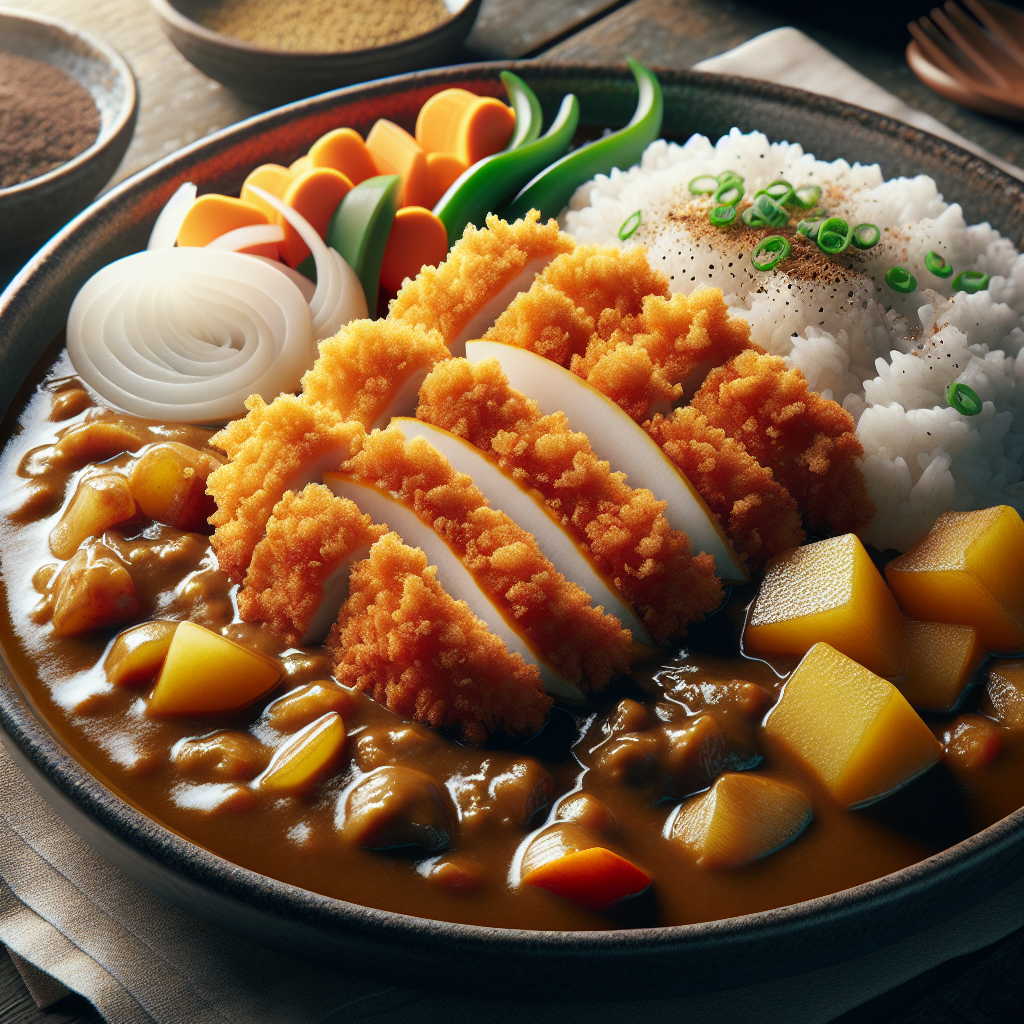
Transform your dinner with this irresistible Japanese Curry Rice topped with crispy panko-crusted chicken katsu. This home-style favorite combines golden-brown chicken cutlets with a rich, thick curry sauce that's both comforting and deeply satisfying. Perfect for anyone craving authentic Japanese flavors at home!
Ingredients for Crispy Chicken Katsu Curry: Easy Japanese Comfort Food
- 21oz Chicken Breasts
- 7oz Panko Breadcrumbs
- 3.5oz All-Purpose Flour
- 2 whole Eggs
- 8oz Japanese Curry Roux Blocks
- 7oz Onion, diced
- 5oz Carrots, diced
- 7oz Potato, cubed
- 4oz Vegetable Oil
- 2 tsp Salt
- 1 tsp Black Pepper
- 21oz Cooked Japanese Rice
Instructions for Crispy Chicken Katsu Curry: Easy Japanese Comfort Food
- Season chicken breasts with 1 tsp salt and 0.5 tsp black pepper. Set up breading station: one plate with 3.5oz flour, one bowl with beaten eggs, and one plate with 7oz panko breadcrumbs.
- Coat each chicken breast in flour, then egg, then panko breadcrumbs, pressing gently to adhere.
- Heat 2oz vegetable oil in a large skillet over medium heat. Once hot, fry chicken for 4-5 minutes each side until golden brown and cooked through. Set aside on paper towels.
- In a large pot, heat 1oz vegetable oil over medium heat. Add 7oz diced onions and cook until softened, about 5 minutes.
- Add 5oz diced carrots and 7oz cubed potatoes. Cook for 2 minutes.
- Add 1 liter/4 cups water and bring to a boil. Reduce heat and simmer for 15 minutes or until vegetables are tender.
- Break 8oz curry roux blocks into pieces and add to the pot. Stir until completely dissolved and sauce thickens, about 5 minutes.
- Season with remaining 1 tsp salt and 0.5 tsp black pepper to taste.
- Slice the chicken katsu and serve over 21oz hot cooked rice, topped with curry sauce.
Bringing Japanese Comfort to Your Kitchen: The Art of Chicken Katsu Curry
There's something magical about Japanese Chicken Katsu Curry that makes it the ultimate comfort food fusion. This beloved dish marries the Western-influenced crispy panko-breaded chicken cutlet with a rich, aromatic curry sauce that's uniquely Japanese. As someone who grew up straddling two culinary cultures, this dish holds a special place in my heart – it perfectly represents how Japanese cuisine has evolved by embracing international influences while maintaining its distinct identity.
In just over an hour (20 minutes prep and 45 minutes cooking time), you can create this restaurant-worthy dish at home. The star is the chicken katsu – juicy chicken breasts (21 oz/600g) encased in a gloriously crispy golden-brown panko coating. When paired with the velvety curry sauce, loaded with tender vegetables and served over steaming rice, it creates a harmony of textures and flavors that's simply irresistible.
Tips for the Perfect Chicken Katsu Curry Every Time
As a chef who's made countless katsu curries, I've collected some crucial tips that will elevate your dish from good to spectacular:
-
Temperature matters: Make sure your oil is at the right temperature (around 350°F/175°C) before frying. Too hot, and the coating burns before the chicken cooks; too cool, and you'll end up with greasy, soggy katsu.
-
The secret to extra crispy katsu: After coating your chicken in panko, let it rest for 5-10 minutes. This helps the breading adhere better during frying.
-
Curry sauce consistency: When adding the curry roux blocks (8 oz/220g), break them into smaller pieces first. They'll dissolve more evenly, creating a smoother sauce.
-
Vegetable timing: Add your vegetables in stages. Onions first, then carrots and potatoes. This ensures each vegetable is perfectly cooked – no mushy carrots or undercooked potatoes.
-
Don't rush the sauce: Let it simmer gently after adding the curry roux. This develops a deeper, richer flavor and allows the sauce to reach the perfect thickness.
Serving Your Chicken Katsu Curry with Style
The presentation of Chicken Katsu Curry is almost as important as its preparation. Start with a bed of perfectly cooked Japanese rice (21 oz/600g) – it should be fluffy and slightly sticky. Place your sliced katsu at an angle across the rice, then ladle the curry sauce alongside, allowing it to partially cover both the rice and katsu. This creates that iconic presentation you'd find in Japanese curry houses.
For an authentic experience, serve with traditional accompaniments like fukujinzuke (pickled vegetables) or rakkyo (pickled scallions). A small portion of shredded cabbage on the side adds freshness and crunch. Remember, each serving provides a satisfying 850 calories, making it a wholesome main course that will keep you energized throughout the day.
From My Grandmother's Kitchen to Yours: A Katsu Curry Story
My journey with Chicken Katsu Curry began in my grandmother's tiny Tokyo kitchen. While curry wasn't originally Japanese, my grandmother explained how it arrived via British sailors and evolved into something uniquely Japanese. She would make it on rainy days, and the aroma would fill our entire house, making it impossible to concentrate on anything else.
I remember standing on a small stool, barely tall enough to see over the counter, watching her methodically bread the chicken cutlets. She taught me that patience was key – rushing the process would result in uneven coating and gaps in the crispy exterior. "The sound," she would say, "listen for the sound when you fry. It should sing to you." Years later, as a professional chef, I still hear her words every time I prepare this dish.
This recipe is my tribute to those cherished memories, adapted slightly for modern kitchens but maintaining the soul of traditional Japanese curry. Each time I make it, I'm transported back to that small kitchen, standing on my tiptoes, watching my grandmother create magic with simple ingredients and lots of love.
Smart Substitutions for Your Chicken Katsu Curry
As someone who's made countless katsu curries both at home and in professional kitchens, I've learned that flexibility is key. While traditional ingredients create that authentic flavor we all love, here are some tested substitutions that work well:
For the Chicken Katsu:
- Turkey or pork cutlets can replace chicken breasts, just adjust cooking time accordingly
- Gluten-free panko or crushed rice crackers work instead of regular panko
- Cornstarch or rice flour can substitute all-purpose flour
- For egg alternatives, buttermilk or a mixture of 2 tablespoons ground flaxseed with 6 tablespoons water works well
For the Curry Sauce:
- Can't find Japanese curry blocks? Use 3 tablespoons curry powder mixed with 2 tablespoons flour and 1 tablespoon garam masala
- Sweet potatoes offer a delicious alternative to regular potatoes
- Parsnips can replace carrots for a different sweetness
- Any neutral cooking oil works in place of vegetable oil
For the Rice:
- Brown rice, quinoa, or cauliflower rice for a healthier twist
- Udon noodles or ramen make an excellent base too
Nutrition Facts: Understanding Your Katsu Curry
Let's break down what's on your plate with this Japanese comfort classic. Per serving (¼ of the recipe), you're looking at:
- Calories: 850
- Protein: 45g (perfect for muscle maintenance)
- Carbohydrates: 105g (great energy source)
- Fat: 28g (mostly from healthy cooking oil)
- Sugar: 12g (mainly from natural vegetable sources)
This dish offers a well-balanced meal that combines lean protein from the chicken, complex carbohydrates from the rice, and essential nutrients from the vegetables. The curry sauce, while rich, contains turmeric and other spices that provide antioxidant benefits.
Important Allergen Information
For anyone with dietary restrictions, here's what you need to know about this Chicken Katsu Curry:
Contains:
- Wheat (in flour and panko breadcrumbs)
- Eggs
- Possible soy (check curry roux blocks ingredients)
May contain traces of:
- Milk (some curry roux brands)
- Fish (some curry roux brands)
Always check the specific brands of curry roux blocks you're using, as ingredients can vary. For those with celiac disease or gluten sensitivity, this recipe requires significant modification of the breading and curry roux components.
Storage and Reheating Guide
Having grown up eating leftover katsu curry, I can tell you it often tastes even better the next day! Here's how to store it properly:
Refrigerator Storage:
- Curry sauce: 3-4 days in an airtight container
- Cooked chicken katsu: 2-3 days separated from the sauce
- Cooked rice: 3-4 days in an airtight container
Freezer Storage:
- Curry sauce: Up to 3 months
- Chicken katsu: Up to 2 months (though breading may soften)
- Rice: Up to 1 month
Reheating Tips:
- Sauce: Gentle heating on stovetop with a splash of water
- Chicken: Reheat in oven at 350°F (175°C) for 10-15 minutes to restore crispiness
- Rice: Sprinkle with water and microwave, covered
Frequently Asked Questions About Chicken Katsu Curry
Q: Can I make the curry sauce ahead of time? A: Absolutely! The curry sauce actually develops better flavor overnight.
Q: Why isn't my chicken katsu crispy? A: Ensure your oil is hot enough (350°F/175°C) and don't overcrowd the pan.
Q: Can I bake the chicken instead of frying? A: Yes! Bake at 400°F (200°C) for 20-25 minutes, spraying with oil for better browning.
Q: How thick should I pound the chicken? A: Aim for about ½ inch (1.2 cm) thickness for even cooking.
Q: My curry sauce is too thick/thin? A: Adjust with water to thin or simmer longer to thicken.
Final Thoughts on This Beloved Japanese Dish
This Chicken Katsu Curry recipe truly represents the beautiful fusion of Western and Japanese cuisines that occurred during the Meiji era. As someone who grew up watching my grandmother make this dish, I can tell you that while it requires some effort, the result is absolutely worth it. The combination of crispy chicken katsu and rich curry sauce creates a harmony of textures and flavors that's made this dish a global favorite.
Remember, practice makes perfect with the breading technique, and don't be afraid to adjust the curry's thickness to your preference. Whether you're making this for a casual family dinner or a special occasion, this recipe will bring authentic Japanese comfort food right to your table. With proper storage and reheating, you can enjoy this delicious meal for several days – though in my experience, leftovers rarely last that long!
